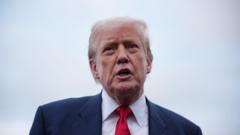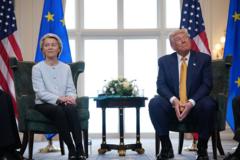U.S. President Donald Trump's recent tariff announcements have sent shockwaves through Southeast Asia's export-driven economies. Countries like Thailand and Vietnam are racing to renegotiate deals, but the complexities of domestic politics, public opinion, and differing economic priorities complicate the process, leaving many manufacturers grappling with uncertainty.
Southeast Asia Grapples with Trump's Tariff Shake-Up

Southeast Asia Grapples with Trump's Tariff Shake-Up
Countries scramble to renegotiate trade deals amid daunting U.S. tariff impositions.
In a sweeping move that sent shockwaves across Southeast Asia, U.S. President Donald Trump announced a new wave of tariffs on April 2, with some countries facing rates as high as 49%. The focus on export-driven economies, particularly Thailand and Vietnam, highlights the significant impact this has had on regional industries ranging from electronics to textiles.
Richard Han, CEO of Thailand's Hana Microelectronics, detailed the moment of the announcement. "I thought: 'Did I see that right? 36%? How could it be?" he recalled, referring to the proposed rate for Thailand. Fortunately for the country, a negotiation brought the potential levy down to 19%—yet the details remain murky amidst political hijinks and deadline pressures.
Vietnam was quick to act, striking a deal to reduce its harsh 46% tariff to 20%, with promises of no new tariffs on American imports. However, no formal documentation has surfaced, leaving confusion over the exact terms. Following Vietnam's lead, Indonesia and the Philippines also secured their own agreements, cutting tariffs to 19%—a move complicated by their comparatively lower reliance on U.S. exports.
Thailand, heavily reliant on trade—with a reported $63 billion coming from the U.S.—was positioned to lead negotiations. Yet, political realities intervened. With a weak coalition government and various domestic interests to manage, Thai representatives faced hurdles when addressing U.S. demands, particularly concerning agricultural market access—a sensitive issue for a nation that prides itself on its agribusiness sector.
The backlash from past actions, like the controversial repatriation of Uyghur asylum-seekers, further complicated Thailand's position. U.S. negotiators reportedly cited this grievance throughout tariff discussions. Unlike Vietnam's more centralized approach to decision-making, Thailand's democratic process often leads to prolonged negotiations.
Domestic pressure from the agricultural sector clashed with the outcry from the manufacturing industry. As key exports hung in the balance, numerous manufacturers warned that a 36% tariff could endanger their competitiveness and survival in the U.S. market.
Suparp Suwanpimolkul, from SK Polymer, expressed the dire implications tariffs would have on pricing and operations. While he remained cautiously optimistic about surviving with a 20% tariff, many worry about the uncertainty it introduces to business planning.
This unpredictability extends to the entire Southeast Asian market, especially concerning trans-shipping—where China may route products through these nations to avoid tariffs. The intricacies of central supply chains, heavily reliant on Chinese materials, present a daunting challenge for companies vying to meet U.S. demands while staying competitive.
As Trump’s erratic tariff policies continue to evolve, Southeast Asian economies are left scrambling for clarity. Business leaders like Han emphasize the urgency for stable trade rules to ease the mounting tension, stating, “The trouble is, we don't know what the rules of the game are going to be.” The ambiguity leaves the region's exporters guessing and anxious about the future of their businesses in the international market.





















